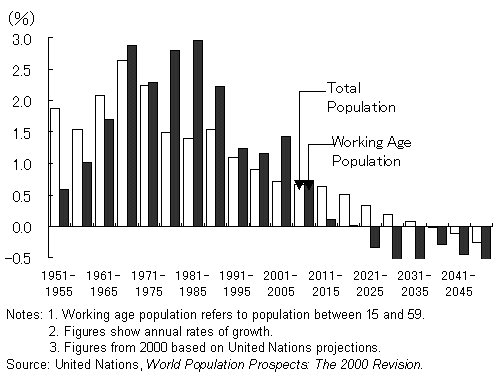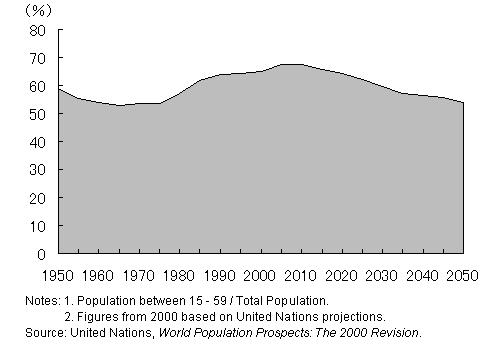China has come to enjoy a remarkable economic growth rate that has averaged nearly 10 percent per annum since the economic reform process started in the late 1970s. One of the factors that have made such progress possible is the virtually unlimited supply of labor. The number of productive workers between the ages of 15 to 59 expanded at an impressive 2.5 percent a year between 1961 and 1990.
But, the expansion of China's working-age population has gradually begun to taper off, thanks to the government's birth control policy adopted from the early 1980s that limited families to just one child. Should this trend continue, it could act as a constraint that limits economic growth from the supply side in the long run.
Following the implementation of the one-child policy, the average annual birth rate of China has exhibited a sharp decrease, tumbling from 6.1 percent posted over 1965-1970 to just 1.8 percent in 1996-2000. The rate of population growth has consequently weakened since 1980-whereas the figure stood at 2.2 percent in 1961-1980, it fell to less than 1 percent in 1996-2000 ( figure 1 ). According to a United Nations projection, China's population growth will turn negative in 2035.
Meanwhile, the growth rate of China's working-age population has begun to slacken at a comparatively slower pace than that of the general population, managing to maintain an average rate of 1.2 percent over 1996-2000. Nevertheless, the UN projects that China's working-age population growth will gradually slow until it halts altogether by 2020, and then slide into negative growth from that year onward. This shift, in turn, will lead to a contraction in the ratio of China's working age population to the general population, from the 65 percent of today to less than 55 percent in 2050 ( figure 2 ).
A contracting working-age population will adversely impact economic growth in two ways. First, it leads directly to a decrease in labor supply. Secondly, the more the population "pyramid" inverts itself as the number of senior citizens increases, the greater the likelihood that the nation's savings rate will decline. A declining savings rate implies less capital for investment, and would thus be an indirect drag on economic growth.
We estimate that economic growth will begin to suffer the effects of a growing labor shortfall through the causes mentioned above after 2010, the year when the working-age population growth rate is expected to peak. From 2020, the rate of working-age population growth will turn negative, thereby further dampening China's potential economic growth rate.
It should be noted, however, that China presently possesses an enormous surplus of labor reaching up to the hundreds of millions in rural communities, with prospects of full employment far from being achieved any time soon. Should this massive surplus labor continue to be channeled into industrial sectors over time, we may allay concerns that the tapering of labor force growth rates will act as a brake on China's economic growth in the near future.
The evaluation of China's economic prospects based on demographic factors reinforces our belief that the nation can sustain a high rate of economic development for some time to come. Ten to 20 years from now, however, the Chinese government's single-child policy may very well come back to haunt it in the form of an aging population and a decreasing savings rate, to usher in the end of the high growth era. Thus, the next 20 years may turn out to be China's last chance to join the ranks of industrialized nations.
Figure 1: China's falling population growth rates

Figure 2: China's working age population ratio



